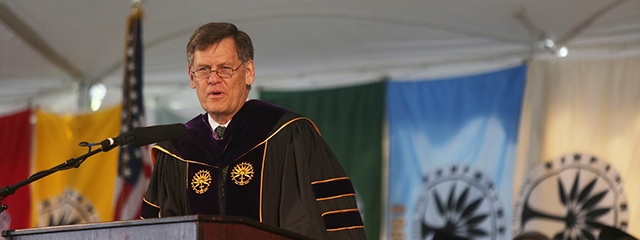Hampshire College President Jonathan Lash recently blogged for the Huffington Post on mathematics education.
My last post looked at math as part of an inquiry-driven, interdisciplinary curriculum, with the focus on the individual learner’s questions and needs. Let’s turn now to some of the values and aspirations informing that approach — inclusion, inspiration, empowerment, and positive change.
Who does math? Or, of more immediate significance to students, who teaches math? Two math professors are on Hampshire’s faculty, Sarah Hews and Geremías Polanco Encarnación. Together, they present a richness of models of who does math, including women, people of color, international scholars, and first-generation scholars. They inspire and empower students by who they are and by how they teach.
Professors who don’t need to check off boxes or compare performance can concentrate on assisting students in developing the skills and confidence to grow as independent learners. Yes, students learn content, but also much more. They learn to take ownership of their own education and how to negotiate with their professors and others as they progress.
With all the basic courses and resources now available online, teaching math is no longer just providing content. Professors can point students toward online materials that will assist them in learning concepts or filling in gaps.
Many times, pooled resources are available in educational settings. In addition to classes on campus and online materials, our students can enroll in courses at any of the other schools in the Five College consortium, greatly expanding their options. The negotiating skills they build as they move through an individualized program are quickly put to use incorporating resources across the consortium into their studies.
Let me illustrate with an example: One student grew interested in how and why first responders in emergency medicine make decisions. After completing the Calculus in Context course, he wanted to learn more about decision theory. He approached a professor at Amherst College and asked what he really needed to know to take a course being offered there. The question was about concepts rather than prerequisites or course titles. He researched and learned the necessary concepts and enrolled in the professor’s Probability Theory class, and then wrote his Hampshire thesis on medical decision-making theory. No surprise, he’s on his way to med school.
Such confidence doesn’t come easily to every student, but negotiating the educational process, with adequate support, certainly helps build it.
Professor Polanco describes this approach as giving students tools that will enable them to use, research, or create new maths at the forefront of their chosen fields. Not every student will pursue math as a field, but they will need mathematical tools to be more informed scientists, scholars, or citizens.
For some students, a smooth transition from simple to complex ideas can help overcome math anxiety and build confidence. Some, working in fields other than math, learn concepts and skills necessary in their work. But what about those with a passion for mathematics, who might major in math at a more traditional school? They’re math concentrators; our professors find they thrive in courses that let them learn material quickly and expand on it without being stuck doing rote.
This is important. While focused on the individual learner, this model of education is also about the future. Educating for change includes changing education. Professors Polanco and Hews feel they’re working with, and inspiring, a generation of young scholars who are developing within this system, a strong percentage of whom will go on to earn doctorates and be able to impact education in math and in other fields in the future in a way that will break barriers for many people that may be being left out.





